Inventory and Spatial Distribution of Landslides on the Eastern Slope of Gongga Mountain, Southwest China
Abstract
1. Introduction
2. Materials and Methods
2.1. Study Area
2.2. Data
2.3. Methods
3. Results
3.1. Landslide Inventory and Spatial Distribution
3.2. Temporal Distribution
3.3. Topographic Factors
3.4. Geological Factors
3.5. Earthquake Factors
3.6. Mobility Indices
4. Discussion
4.1. Comparison of Landslide Inventories
4.2. Distribution Characteristics and Main Control Factors of Landslides in Different Valleys
5. Conclusions
Author Contributions
Funding
Data Availability Statement
Acknowledgments
Conflicts of Interest
References
- Valagussa, A.; Marc, O.; Frattini, P.; Crosta, G.B. Seismic and geological controls on earthquake-induced landslide size. Earth Planet. Sci. Lett. 2019, 506, 268–281. [Google Scholar] [CrossRef]
- Aditian, A.; Kubota, T.; Shinohara, Y. Comparison of GIS-based landslide susceptibility models using frequency ratio, logistic regression, and artificial neural network in a tertiary region of Ambon, Indonesia. Geomorphology 2018, 318, 101–111. [Google Scholar] [CrossRef]
- Zhang, D.; Wu, Z.; Li, J.; Jiang, Y. An Overview on Earthquake-Induced Landslide Research. J. Geomech. 2013, 19, 225–241. [Google Scholar]
- Cui, Y.; Bao, P.; Xu, C.; Ma, S.; Zheng, J.; Fu, G. Landslides triggered by the 6 September 2018 Mw 6.6 Hokkaido, Japan: An updated inventory and retrospective hazard assessment. Earth Sci. Inform. 2021, 14, 247–258. [Google Scholar] [CrossRef]
- Tanyas, H.; Hill, K.; Mahoney, L.; Fadel, I.; Lombardo, L. The world’s second-largest, recorded landslide event: Lessons learnt from the landslides triggered during and after the 2018 Mw 7.5 Papua New Guinea earthquake. Eng. Geol. 2022, 297, 106504. [Google Scholar] [CrossRef]
- Zhao, B. Landslides triggered by the 2018 Mw 7.5 Palu supershear earthquake in Indonesia. Eng. Geol. 2021, 294, 106406. [Google Scholar] [CrossRef]
- Huang, Y.; Xie, C.; Li, T.; Xu, C.; He, X.; Shao, X.; Xu, X.; Zhan, T.; Chen, Z. An open-accessed inventory of landslides triggered by the MS 6.8 Luding earthquake, China on September 5, 2022. Earthq. Res. Adv. 2023, 3, 100181. [Google Scholar] [CrossRef]
- Guzzetti, F.; Mondini, A.C.; Cardinali, M.; Fiorucci, F.; Santangelo, M.; Chang, K. Landslide inventory maps: New tools for an old problem. Earth-Sci. Rev. 2012, 112, 42–66. [Google Scholar] [CrossRef]
- Xu, Q.; Dong, X.; Li, W. Integrated Space-Air-Ground Early Detection, Monitoring and Warning System for Potential Catastrophic Geohazards. Geomat. Inf. Sci. Wuhan Univ. 2019, 44, 957–966. [Google Scholar]
- Zhao, C.; Lu, Z. Remote Sensing of Landslides—A Review. Remote Sens. 2018, 10, 279. [Google Scholar] [CrossRef]
- Xu, Q.; Tang, M.; Xu, K.; Huang, X. Research on Space-Time Evolution Laws and Early Warning-Prediction of Landslides. Chin. J. Rock Mech. Eng. 2008, 27, 1104–1112. [Google Scholar]
- Xiong, J.; Chen, H.; Zeng, L.; Su, F.; Gong, L.; Tang, C. Coseismic landslide sediment increased by the “9.5” Luding earthquake, Sichuan, China. J. Mt. Sci. 2023, 20, 624–636. [Google Scholar] [CrossRef]
- Wang, X.; Fang, C.; Tang, X.; Dai, L.; Fan, X.; Xu, Q. Research on Emergency Evaluation of Landslides Induced by the Luding Ms 6.8 Earthquake. Geomat. Inf. Sci. Wuhan Univ. 2023, 48, 25–35. [Google Scholar]
- Fan, X.; Wang, X.; Dai, L.; Fang, C.; Deng, Y.; Zou, C.; Tang, M.; Wei, Z.; Dou, X.; Zhang, J.; et al. Characteristics and spatial distribution pattern of Ms 6.8 Luding earthquake occurred on September 5, 2022. J. Eng. Geol. 2022, 30, 1504–1516, (In Chinese with English Abstract). [Google Scholar] [CrossRef]
- Zhang, J.; Yang, Z.; Meng, Q.; Wang, J.; Hu, K.; Ge, Y.; Su, F.; Zhao, B.; Zhang, B.; Jiang, N.; et al. Distribution patterns of landslides triggered by the 2022 MS 6.8 Luding earthquake, Sichuan, China. J. Mt. Sci. 2023, 20, 607–623. [Google Scholar] [CrossRef]
- Ma, S.; Lu, Y.; Xia, C.; Liu, X.; Qi, W.; Yuan, R. Brief report of landslides triggered by the 2022 Ms 6.8 Luding earthquake, Sichuan, China. Landslides 2023, 20, 2695–2707. [Google Scholar] [CrossRef]
- Kamp, U.; Growley, B.J.; Khattak, G.A.; Owen, L.A. GIS-based landslide susceptibility mapping for the 2005 Kashmir earthquake region. Geomorphology 2008, 101, 631–642. [Google Scholar] [CrossRef]
- Dai, F.; Xu, C.; Yao, X.; Xu, L.; Tu, X.; Gong, Q. Spatial distribution of landslides triggered by the 2008 Ms 8.0 Wenchuan earthquake, China. J. Asian Earth Sci. 2011, 40, 883–895. [Google Scholar] [CrossRef]
- Xu, C.; Xu, X.; Shyu, J.B.H. Database and spatial distribution of landslides triggered by the Lushan, China Mw 6.6 earthquake of 20 April 2013. Geomorphology 2015, 248, 77–92. [Google Scholar] [CrossRef]
- Sepúlveda, S.A.; Serey, A.; Lara, M.; Pavez, A.; Rebolledo, S. Landslides induced by the April 2007 Aysén Fjord earthquake, Chilean Patagonia. Landslides 2010, 7, 483–492. [Google Scholar] [CrossRef]
- Kargel, J.S.; Leonard, G.J.; Shugar, D.H.; Haritashya, U.K.; Bevington, A.; Fielding, E.J.; Fujita, K.; Geertsema, M.; Miles, E.S.; Steiner, J.; et al. Geomorphic and geologic controls of geohazards induced by Nepal’s 2015 Gorkha earthquake. Science 2016, 351, 147. [Google Scholar] [CrossRef]
- Zhang, J.; Chen, L.; Li, Y.; Liu, M.; Shi, S.; Yi, J.; Zhang, W.; Zhang, S.; Sun, J.; Yang, D.; et al. Development characteristics and controlling factors of coseismic geohazards triggered by the Luding Ms 6.8 earthquake occurred on September 5, 2022. Acta Seismol. Sin. 2023, 45, 167–178, (In Chinese with English Abstract). [Google Scholar]
- Guo, C.; Li, C.; Yang, Z.; Ni, J.; Zhong, N.; Wang, M.; Yan, Y.; Song, D.; Zhang, Y.; Zhang, X.; et al. Characterization and spatial analysis of coseismic landslides triggered by the Luding Ms 6.8 earthquake in the Xianshuihe fault zone, Southwest China. J. Mt. Sci. 2024, 21, 160–181. [Google Scholar] [CrossRef]
- Zhao, B.; Hu, K.; Yang, Z.; Liu, Q.; Zou, Q.; Chen, H.; Zhang, B.; Zhang, W.; Zhu, L.; Su, L. Geomorphic and tectonic controls of landslides induced by the 2022 Luding earthquake. J. Mt. Sci. 2022, 19, 3323–3345. [Google Scholar] [CrossRef]
- Liu, X.; Su, P.; Li, Y.; Xia, Z.; Ma, S.; Xu, R.; Lu, Y.; Li, D.; Lu, H.; Yuan, R. Spatial distribution of landslide shape induced by Luding Ms 6.8 earthquake, Sichuan, China: Case study of the Moxi Town. Landslides 2023, 20, 1667–1678. [Google Scholar] [CrossRef]
- An, Y.; Wang, D.; Ma, Q.; Xu, Y.; Li, Y.; Zhang, Y.; Liu, Z.; Huang, C.; Su, J.; Li, J.; et al. Preliminary report of the September 5, 2022 MS 6.8 Luding earthquake, Sichuan, China. Earthq. Res. Adv. 2023, 3, 100184. [Google Scholar] [CrossRef]
- Tie, Y.; Zhang, X.; Lu, J.; Liang, J.; Wang, D.; Ma, Z.; Li, Z.; Lu, T.; Shi, S.; Liu, M.; et al. Characteristics of geological hazards and it’s mitigations of the Ms 6.8 earthquake in Luding County, Sichuan Province. Hydrogeol. Eng. Geol. 2022, 49, 1–12. [Google Scholar]
- Zhao, B.; Li, W.; Su, L.; Wang, Y.; Wu, H. Insights into the Landslides Triggered by the 2022 Lushan Ms 6.1 Earthquake: Spatial Distribution and Controls. Remote Sens. 2022, 14, 4365. [Google Scholar] [CrossRef]
- Thomas, A. The climate of the Gongga Shan range, Sichuan Province, PR China. Arct. Alp. Res. 1997, 29, 226–232. [Google Scholar] [CrossRef]
- Cao, Z. The characteristics of glacier hydrology in the area of the Gongga Mountains. J. Glaciol. Geocryol. 1995, 17, 73–83. [Google Scholar]
- Su, Z.; Liang, D.; Hong, M. Developing conditions, amounts and distributions of glaciers in Gongga Mountains. J. Glaciol. Geocryol. 1993, 4, 551–558, (In Chinese with English Abstract). [Google Scholar]
- Shen, Z.; Liu, Z.; Wu, J. Altitudinal pattern of flora on the eastern slope of Mt. Gongga. Chin. Biodivers. 2004, 12, 89–98. [Google Scholar]
- Wu, P.; Wang, Y.; Zhu, J. The characteristics of seismic activity on Xianshuihe fault since 1970 and the preliminary study on seismogenesis of the Kangding MS 6.3 earthquake. Earthq. Res. China 2016, 32, 776–786. [Google Scholar]
- Zheng, G.; Wang, H.; Wright, T.J.; Lou, Y.; Zhang, R.; Zhang, W.; Shi, C.; Huang, J.; Wei, N. Crustal Deformation in the India-Eurasia Collision Zone from 25 Years of GPS Measurements. J. Geophys. Res. Solid Earth 2017, 122, 9290–9312. [Google Scholar] [CrossRef]
- Bai, M.; Chevalier, M.; Li, H.; Pan, J.; Wu, Q.; Wang, S.; Liu, F.; Jiao, L.; Zhang, J.; Zhang, L.; et al. Late Quaternary slip rate and earthquake hazard along the Qianning segment, Xianshuihe fault. Acta Geol. Sin. 2022, 96, 2312–2332. [Google Scholar]
- Li, W.; Chen, J.; Lu, H.; Shan, Y.; Li, Z.; Chen, B.; Wu, L.; Xu, Z.; Li, W.; Zhang, P.; et al. Emergency Analysis of the Impact of the Luding Ms 6.8 Earthquake on Hailuogou Glacier. Geomat. Inf. Sci. Wuhan Univ. 2023, 48, 47–57. [Google Scholar]
- Chen, M.; Li, H.; Liu, C.; Pan, F.; Li, X.; Tu, J.; Wang, Y.; He, R.; Wang, H. Comprehensive evaluation of large-scale geological disaster susceptibility based on frequency ratio-hierarchical analysis model: Taking Yuyang River basin as an example. Resour. Environ. Eng. 2024, 38, 63–72, (In Chinese with English Abstract). [Google Scholar] [CrossRef]
- Iverson, R.M.; George, D.L.; Allstadt, K.; Reid, M.E.; Collins, B.D.; Vallance, J.W.; Schilling, S.P.; Godt, J.W.; Cannon, C.M.; Magirl, C.S.; et al. Landslide mobility and hazards: Implications of the 2014 Oso disaster. Earth Planet. Sci. Lett. 2015, 412, 197–208. [Google Scholar] [CrossRef]
- Roback, K.; Clark, M.K.; West, A.J.; Zekkos, D.; Li, G.; Gallen, S.F.; Chamlagain, D.; Godt, J.W. The size, distribution, and mobility of landslides caused by the 2015 Mw 7.8 Gorkha earthquake, Nepal. Geomorphology 2018, 301, 121–138. [Google Scholar] [CrossRef]
- Staron, L. Mobility of long-runout rock flows: A discrete numerical investigation. Geophys. J. Int. 2008, 172, 455–463. [Google Scholar] [CrossRef]
- Aaron, J.; McDougall, S. Rock avalanche mobility: The role of path material. Eng. Geol. 2019, 257, 105126. [Google Scholar] [CrossRef]
- Keefer, D.K. Statistical analysis of an earthquake-induced landslide distribution—The 1989 Loma Prieta, California event. Eng. Geol. 2000, 58, 231–249. [Google Scholar] [CrossRef]
- Wu, S.; Chen, J.; Xu, C.; Zhou, W.; Yao, L.; Yue, W.; Cui, Z. Susceptibility Assessments and Validations of Debris-Flow Events in Meizoseismal Areas: Case Study in China’s Longxi River Watershed. Nat. Hazards Rev. 2020, 21, 05019005. [Google Scholar] [CrossRef]
- Xu, C. Preparation of earthquake-triggered landslide inventory maps using remote sensing and GIS technologies: Principles and case studies. Geosci. Front. 2015, 6, 825–836. [Google Scholar] [CrossRef]
Disclaimer/Publisher’s Note: The statements, opinions, and data contained in all publications are solely those of the individual author(s) and contributor(s) and not of MDPI and/or the editor(s). MDPI and/or the editor(s) disclaim responsibility for any injury to people or property resulting from any ideas, methods, instructions, or products referred to in the content. |



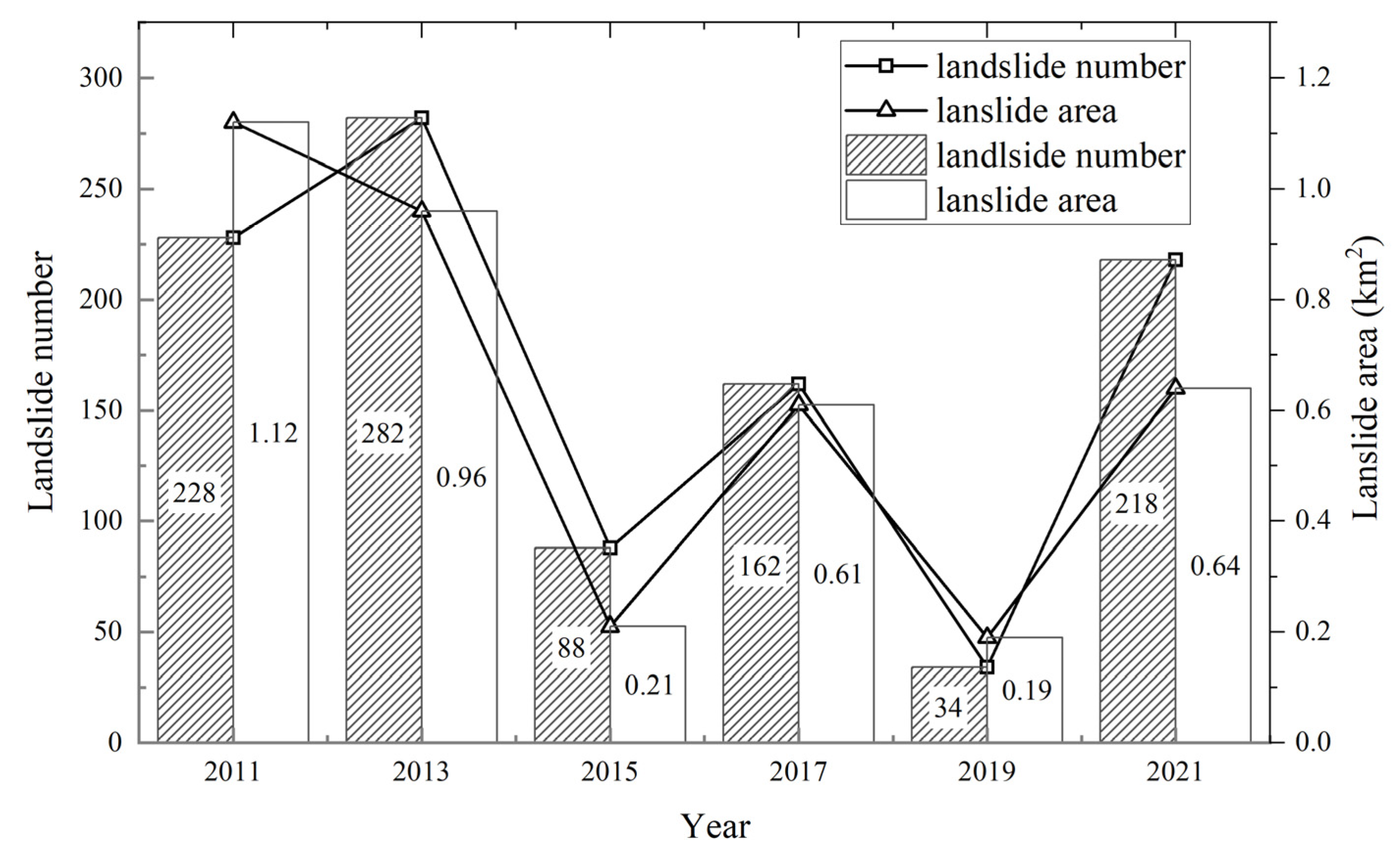
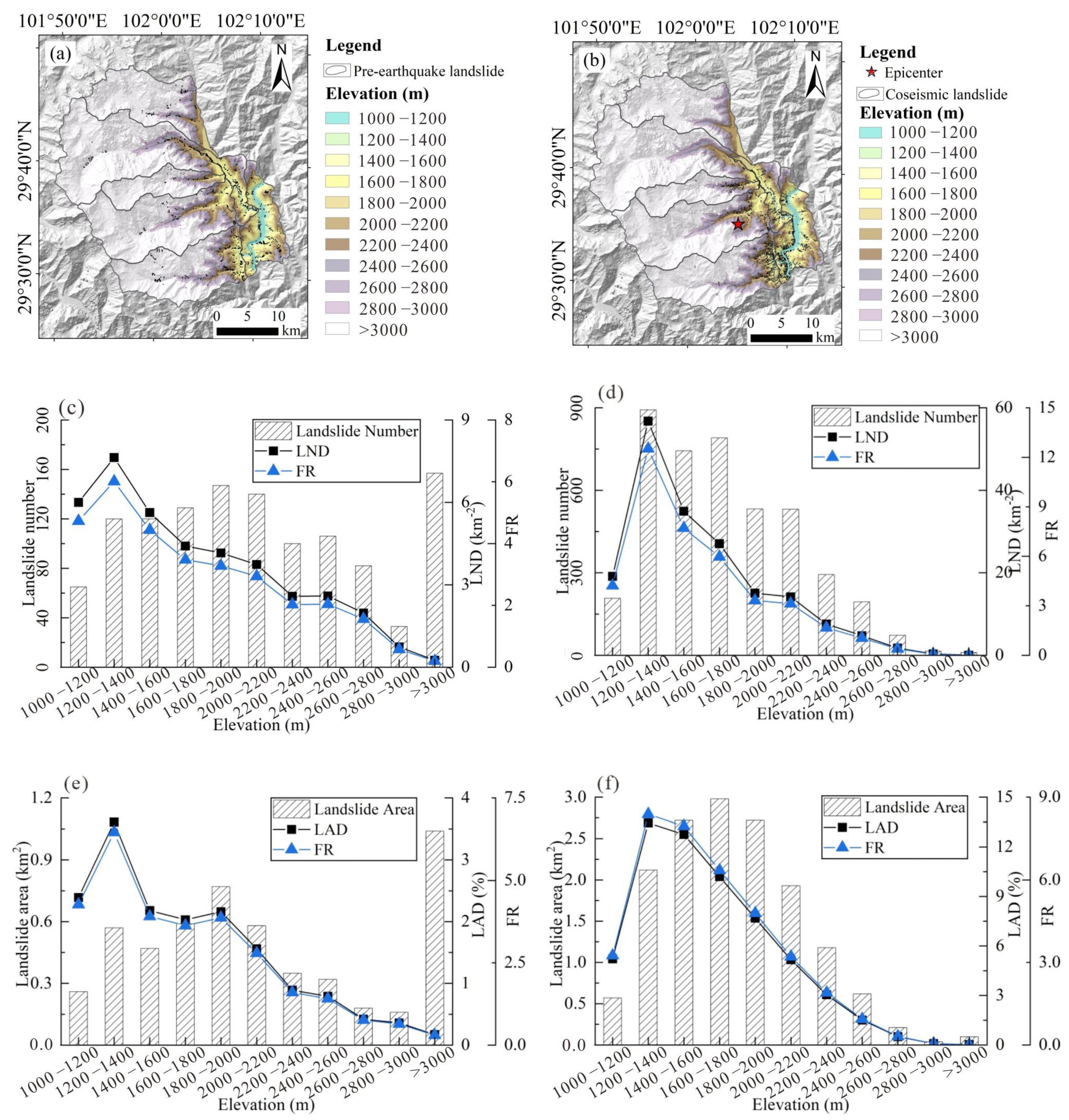

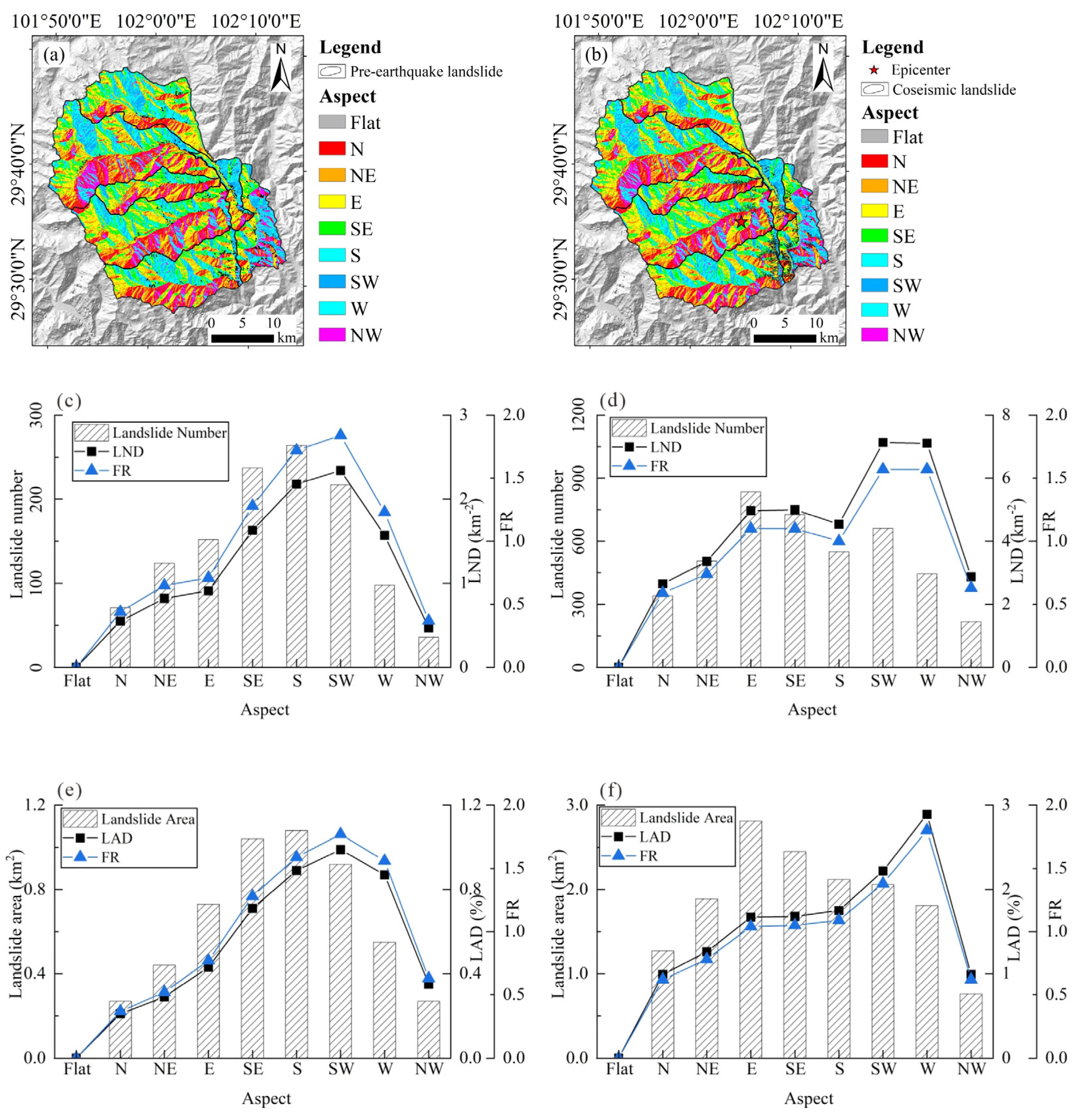

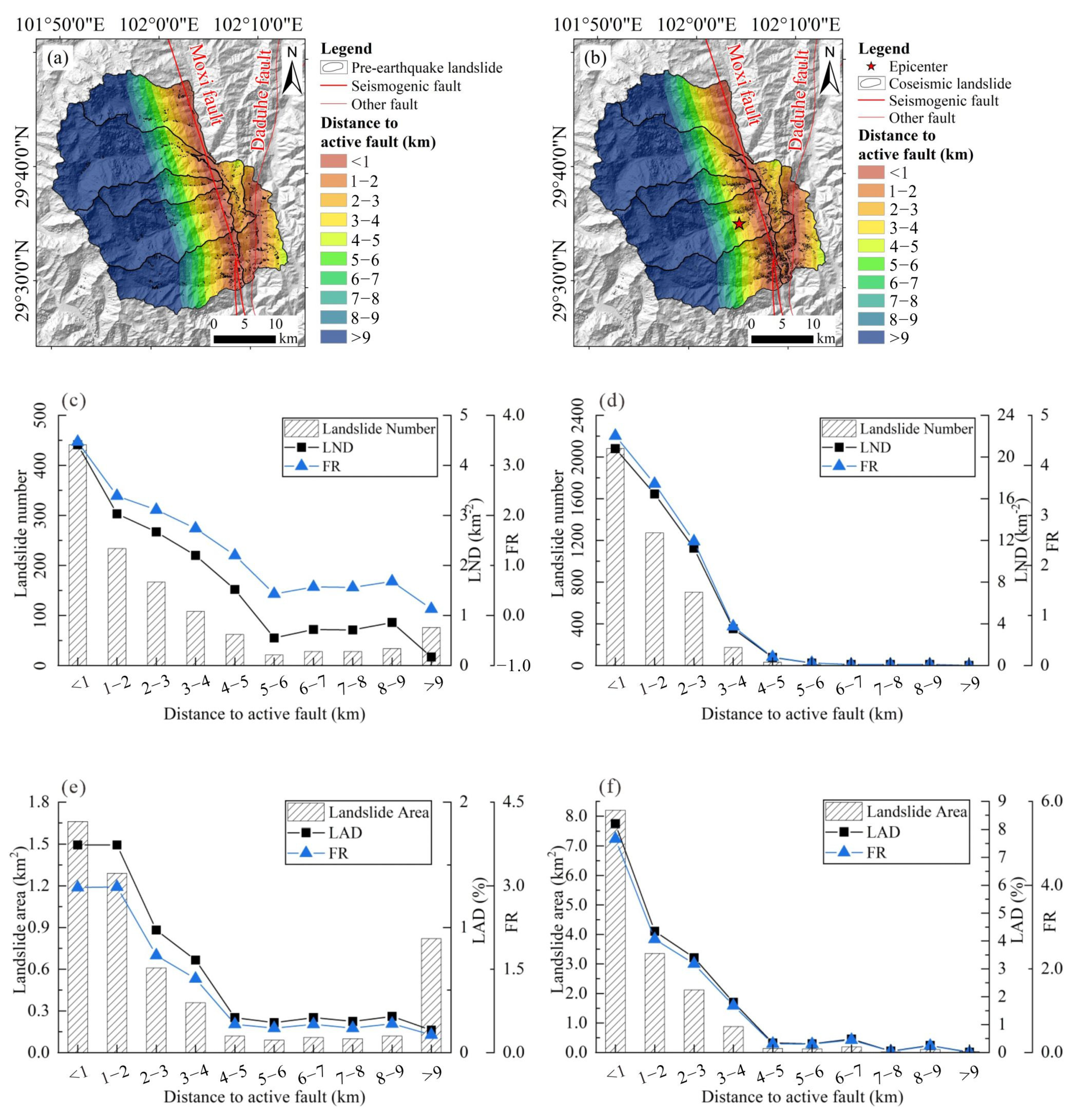
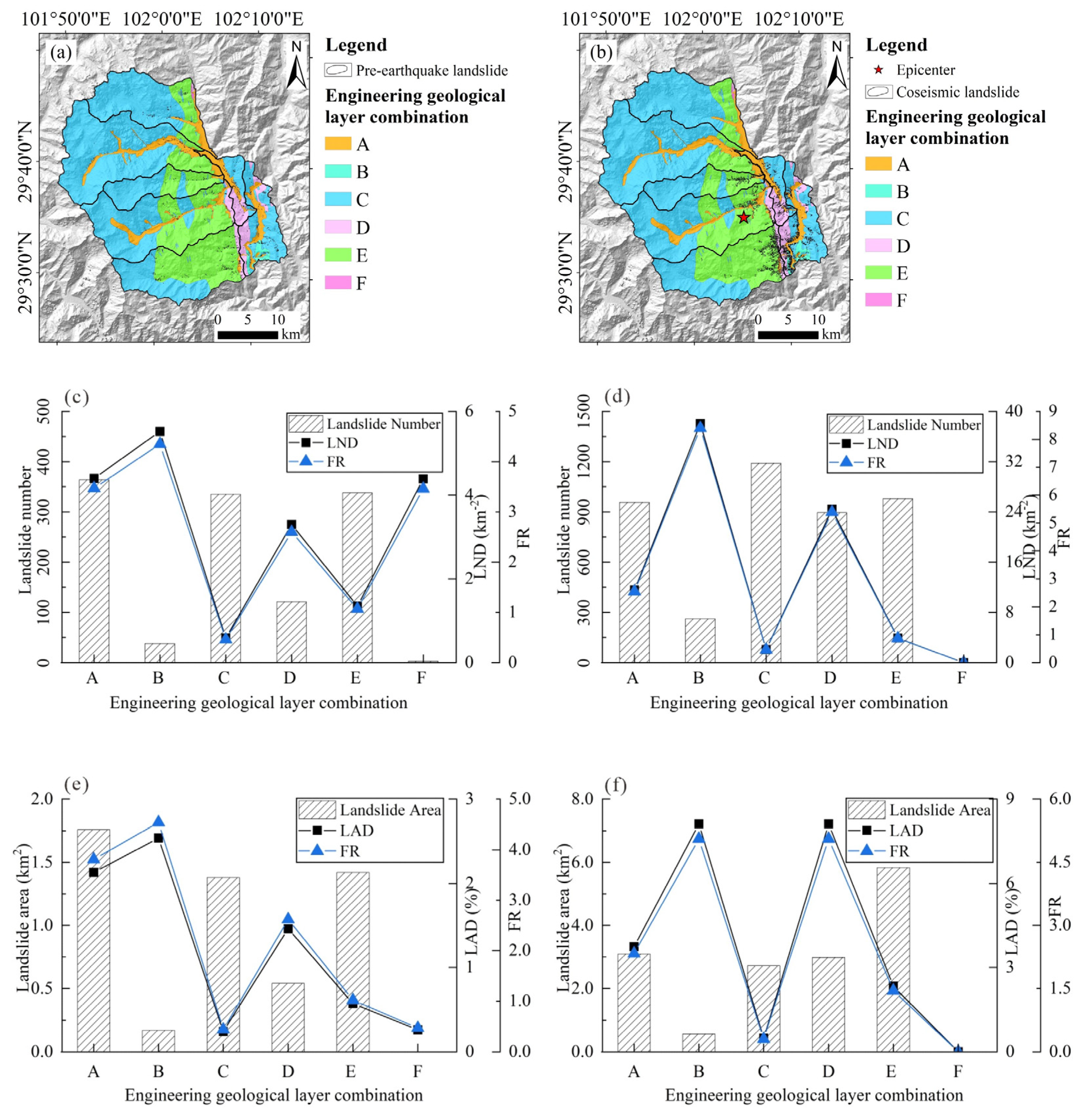

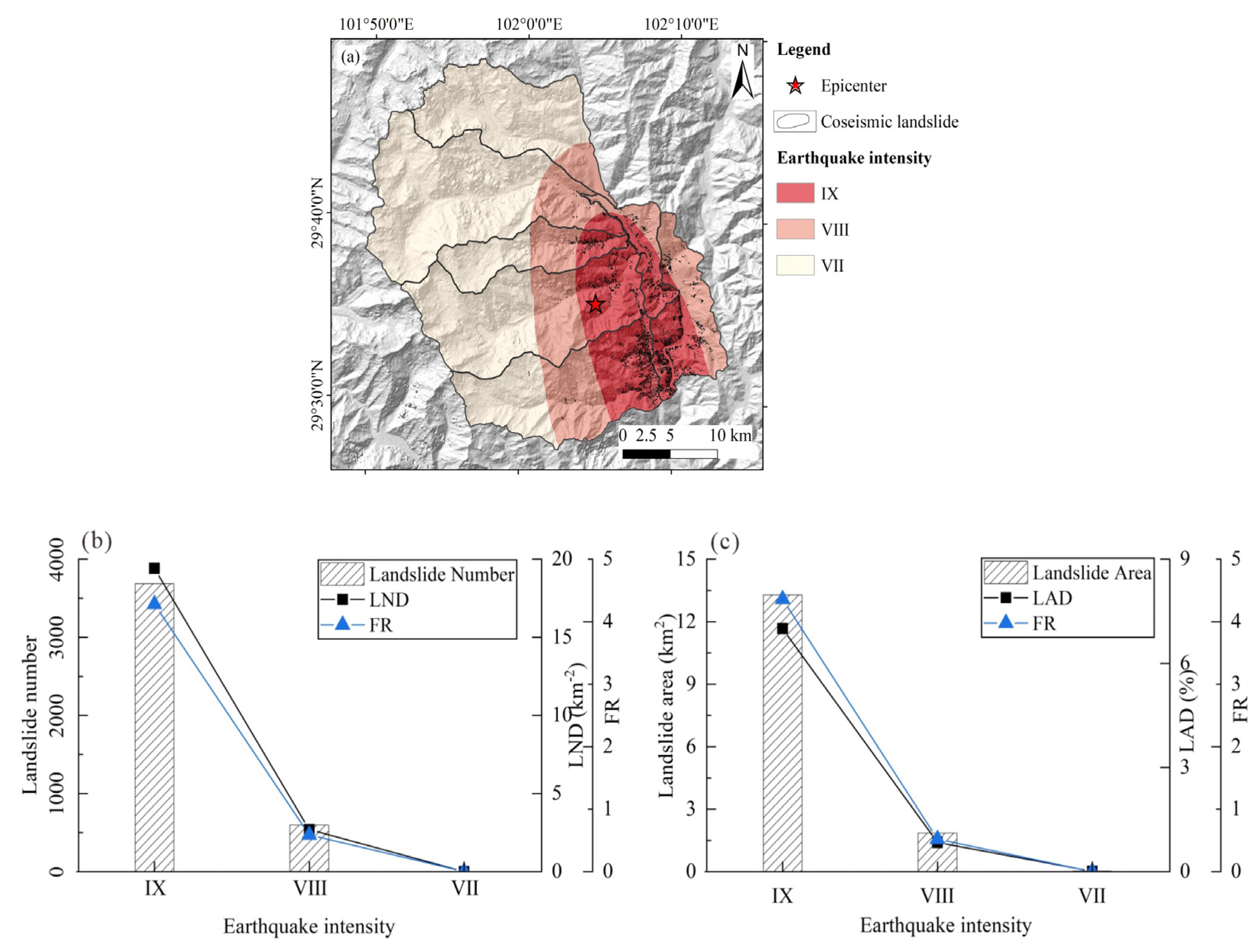



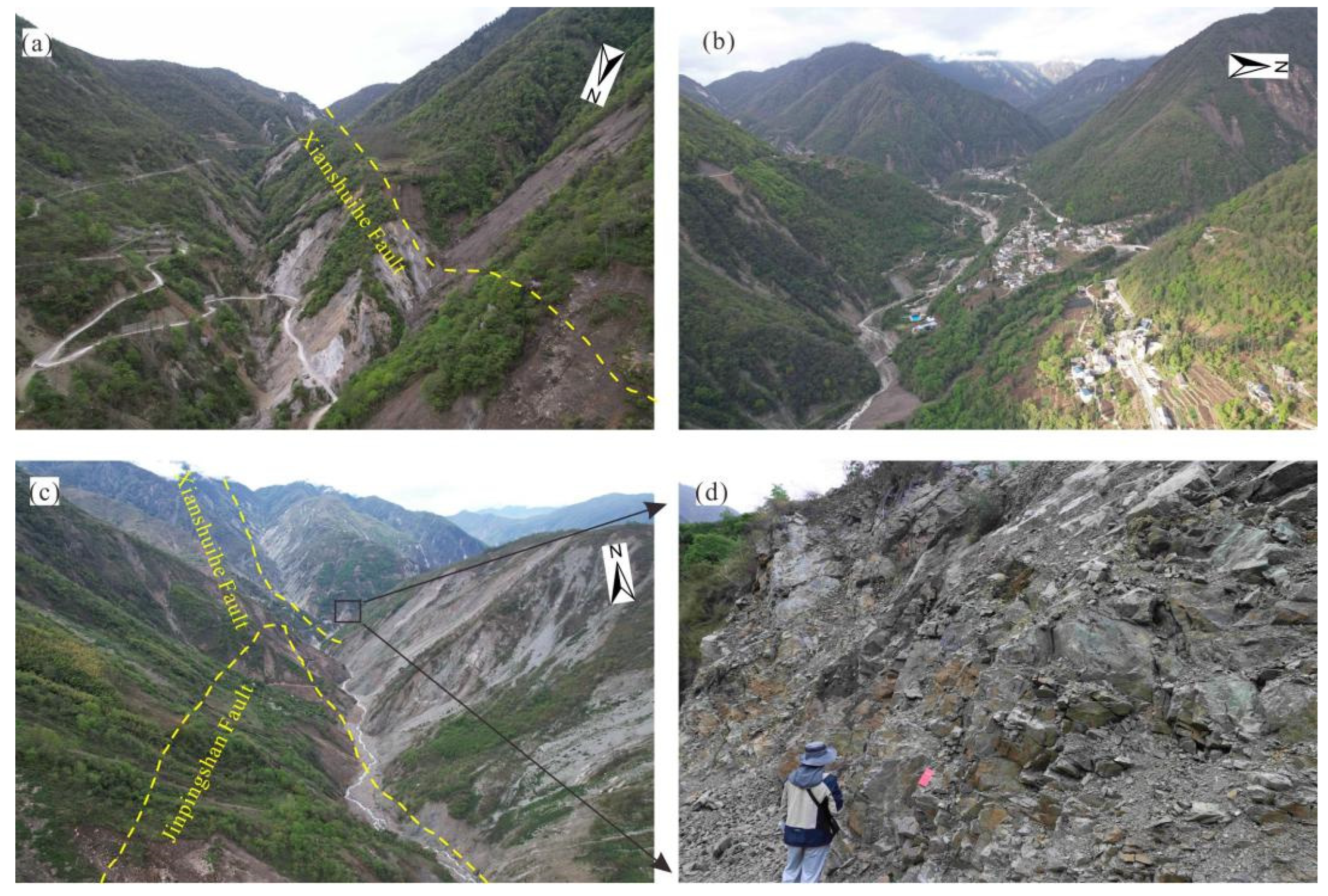
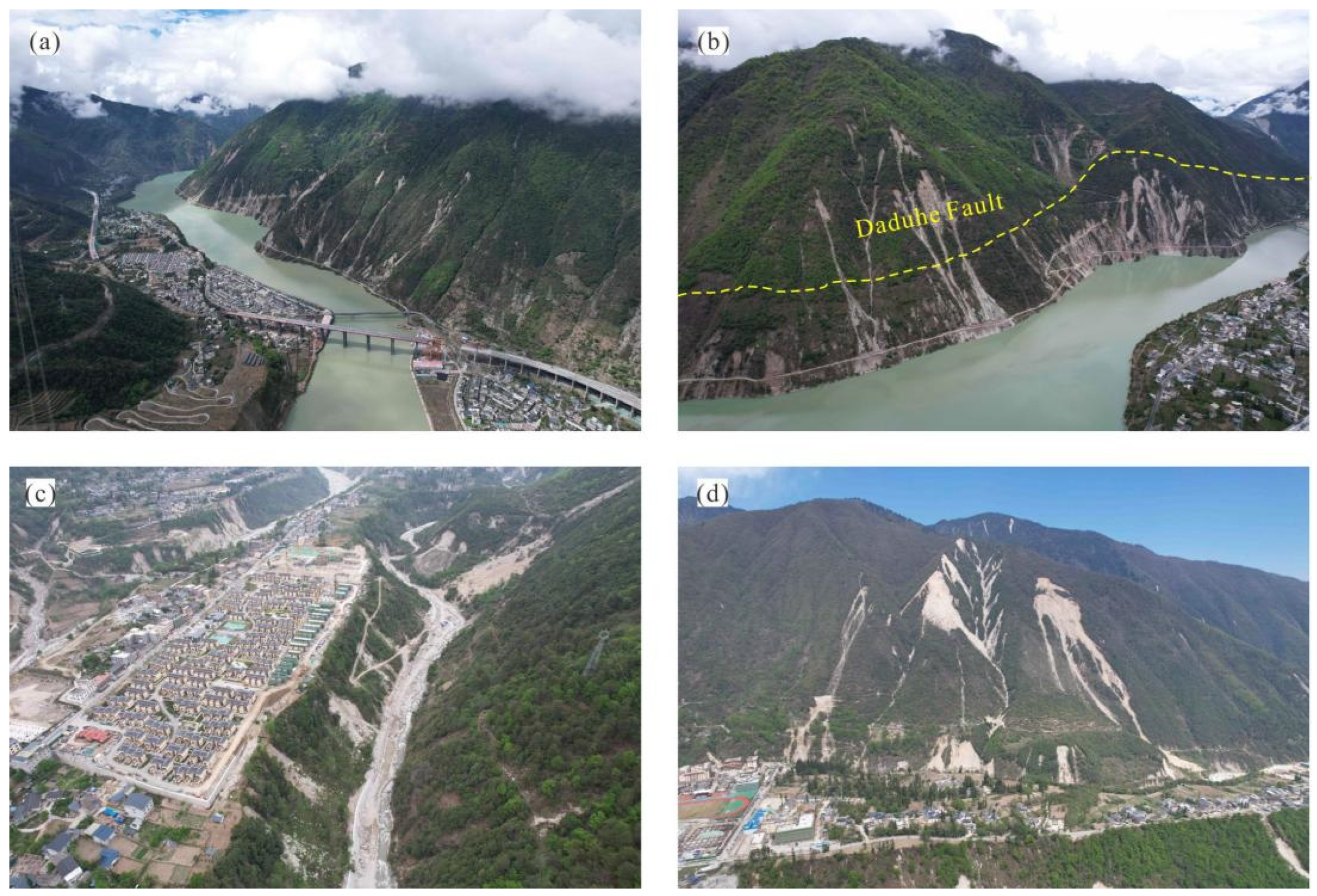
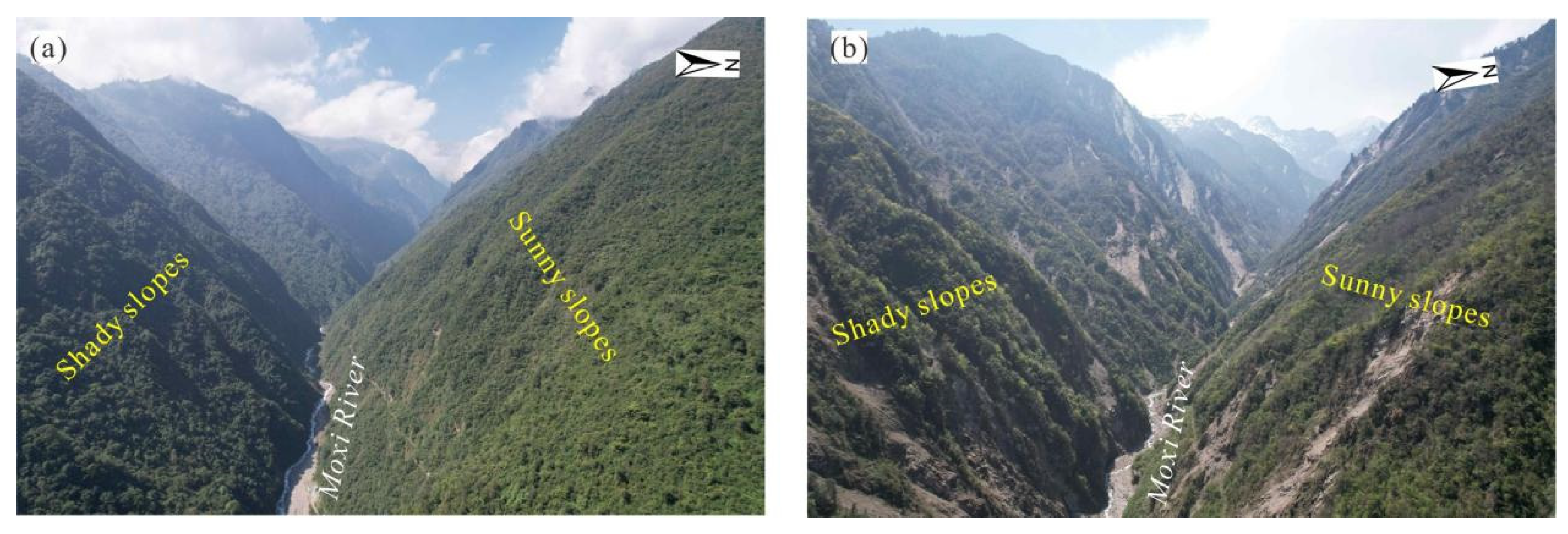
| Engineering Geological Layer Combinations Symbols | Descriptive |
|---|---|
| A | Quaternary loose rock formations dominated by grit, pebbles, and crushed stone |
| B | Semi-hard rock formations such as mudstone, shale, and sandstone interbedded |
| C | Acidic igneous firmament formation |
| D | Meso-basic-ultramafic magmatic hard rock formations |
| E | Slate, metamorphic sandstone, and other semi-hard-to-hard rock formations |
| F | Graystone, marl interbedded with sandstone, mudstone, and hard-to semi-hard rock formations |
| Scope | Area (m2) | Number of Landslides | |
|---|---|---|---|
| Pre-Earthquake | Co-Seismic | ||
| Small size | <104 | 1088 | 3977 |
| Medium size | 104–105 | 106 | 298 |
| Large scale | 105–106 | 4 | 9 |
| Total | 1198 | 4284 | |
| River Basin | Area (km2) | Before the Earthquake | After the Earthquake | ||||||
|---|---|---|---|---|---|---|---|---|---|
| Number of Landslides | LND | Landslide Area | LAD | Number of Landslides | LND | Landslide Area | LAD | ||
| Dagou basin | 163.37 | 257 | 1.573 | 1.147 | 0.007 | 776 | 4.750 | 6.009 | 0.037 |
| Hailougou basin | 203.13 | 145 | 0.714 | 0.663 | 0.003 | 510 | 2.511 | 1.745 | 0.009 |
| Mozigou basin | 73.46 | 49 | 0.667 | 0.154 | 0.002 | 184 | 2.505 | 0.887 | 0.012 |
| Moxi basin | 37.84 | 215 | 5.682 | 0.853 | 0.023 | 762 | 20.139 | 1.884 | 0.050 |
| Dadu River basin | 85.15 | 299 | 3.512 | 1.187 | 0.014 | 1964 | 23.066 | 4.405 | 0.052 |
| Yanzigou basin | 239.00 | 109 | 0.456 | 0.821 | 0.003 | 84 | 0.351 | 0.281 | 0.001 |
| Nanmenguangou basin | 143.15 | 124 | 0.866 | 0.471 | 0.003 | 4 | 0.028 | 0.004 | 0.000 |
| Sum of all | 945.10 | 1198 | — | 5.296 | — | 4284 | — | 15.215 | — |
| Data Bases | Factors | Earthquake Intensity | Engineering Geological Layer Combination | Distance to Fracture | Elevation | Topographic Relief | Aspect | Slope | Distance to the Epicentre | |
|---|---|---|---|---|---|---|---|---|---|---|
| Basin | ||||||||||
| Pre-earthquake | Dagou basin | — | 0.242 | 0.277 | 0.129 | 0.124 | 0.116 | 0.112 | — | |
| Hailuo basin | — | 0.193 | 0.169 | 0.168 | 0.192 | 0.167 | 0.111 | — | ||
| Mozi basin | — | 0.191 | 0.135 | 0.155 | 0.080 | 0.317 | 0.122 | — | ||
| Moxi basin | — | 0.189 | 0.099 | 0.264 | 0.180 | 0.083 | 0.186 | — | ||
| Dadu River basin | — | 0.104 | 0.224 | 0.189 | 0.207 | 0.061 | 0.216 | — | ||
| Yanzigou basin | — | 0.286 | 0.264 | 0.113 | 0.066 | 0.191 | 0.079 | — | ||
| Nanmenguangou basin | — | 0.136 | 0.131 | 0.106 | 0.257 | 0.211 | 0.159 | — | ||
| Co-seismic | Dagou basin | 0.320 | 0.147 | 0.192 | 0.094 | 0.037 | 0.043 | 0.043 | 0.125 | |
| Hailuo basin | 0.295 | 0.064 | 0.094 | 0.085 | 0.087 | 0.080 | 0.074 | 0.221 | ||
| Mozigou basin | 0.250 | 0.166 | 0.108 | 0.048 | 0.067 | 0.082 | 0.073 | 0.207 | ||
| Moxi basin | 0.091 | 0.045 | 0.100 | 0.165 | 0.156 | 0.062 | 0.190 | 0.190 | ||
| Dadu River basin | 0.195 | 0.012 | 0.178 | 0.166 | 0.132 | 0.057 | 0.137 | 0.123 | ||
| Yanzigou Gou | 0.199 | 0.125 | 0.188 | 0.125 | 0.054 | 0.103 | 0.056 | 0.150 | ||
Disclaimer/Publisher’s Note: The statements, opinions and data contained in all publications are solely those of the individual author(s) and contributor(s) and not of MDPI and/or the editor(s). MDPI and/or the editor(s) disclaim responsibility for any injury to people or property resulting from any ideas, methods, instructions or products referred to in the content. |
© 2024 by the authors. Licensee MDPI, Basel, Switzerland. This article is an open access article distributed under the terms and conditions of the Creative Commons Attribution (CC BY) license (https://creativecommons.org/licenses/by/4.0/).
Share and Cite
Ge, R.; Chen, J.; Ma, S.; Tan, H. Inventory and Spatial Distribution of Landslides on the Eastern Slope of Gongga Mountain, Southwest China. Remote Sens. 2024, 16, 3360. https://doi.org/10.3390/rs16183360
Ge R, Chen J, Ma S, Tan H. Inventory and Spatial Distribution of Landslides on the Eastern Slope of Gongga Mountain, Southwest China. Remote Sensing. 2024; 16(18):3360. https://doi.org/10.3390/rs16183360
Chicago/Turabian StyleGe, Runze, Jian Chen, Sheng Ma, and Huarong Tan. 2024. "Inventory and Spatial Distribution of Landslides on the Eastern Slope of Gongga Mountain, Southwest China" Remote Sensing 16, no. 18: 3360. https://doi.org/10.3390/rs16183360
APA StyleGe, R., Chen, J., Ma, S., & Tan, H. (2024). Inventory and Spatial Distribution of Landslides on the Eastern Slope of Gongga Mountain, Southwest China. Remote Sensing, 16(18), 3360. https://doi.org/10.3390/rs16183360








